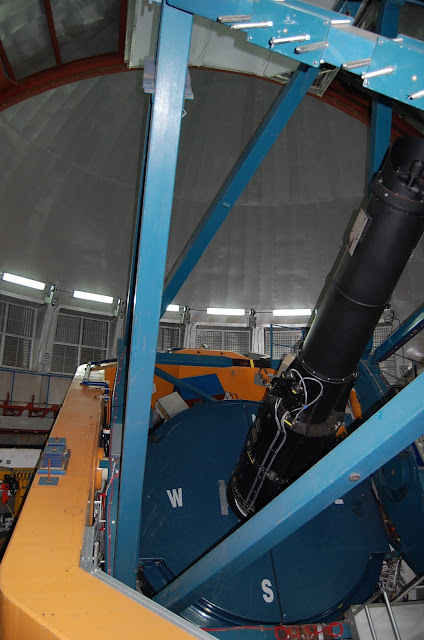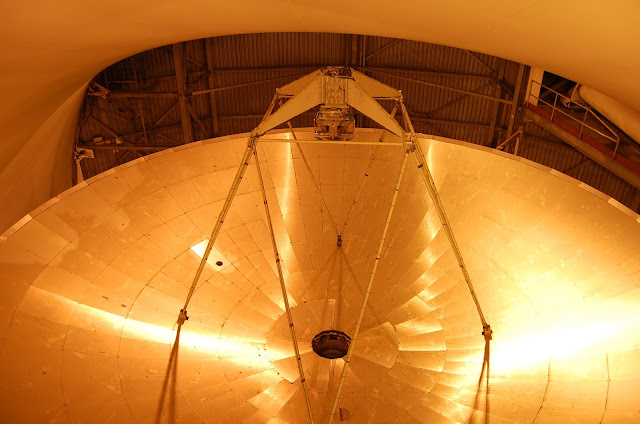Anyway, I'd never been inside UKIRT before this, and only once inside JCMT (as I posted about a month or two ago). That time wasn't for sightseeing, so I got to see a lot more of the telescope this time. You might remember from that post that I got a picture of the telescope from behind, like this:
 |
| The main JCMT dish, lit from beneath. |
 |
| The JCMT primary dish. |
Here's another picture at a slightly different angle, showing the secondary mirror support structure and the grand arch of the overhanging Gore-Tex covering:
If these pictures disorient you as they do me, it may help to remember that the telescope was parked at this time, and the dish is pointing straight up. The metal panels you see in the background are part of the wall. The Gore-Tex is arching over the dish, and provides it protection during operation. (Yes, it's left in place. It's nearly transparent at sub-millimeter wavelengths, so the telescope basically looks right through it.)
Speaking of the Gore-Tex membrane, part of our tour took us near where its upper edge rested (just off to the right in the photo above). It was nicely backlit, and I was inspired to have a friend take some pictures of me with it:
 |
| Deep in thought. |
 |
| A different angle that shows more of the upper edge of the membrane. |
Anyway, after some more looking around we headed up from Sub-millimeter Valley to the ridge where UKIRT is located. The contrast between the two buildings is quite striking, and very interesting (I wish it had been clear enough to get pictures of them from the outside). You see, JCMT is built such that the entire upper portion is one with the telescope, and it all rotates together (yes, the operator room too). This gives it (the building, at any rate) a feeling of lightness, or even unsubstantiability, because except for the first floor everything is built to be light and able to move. UKIRT, however, is built more traditionally, with the building firmly anchored and only the telescope itself able to move, which gives it (again, the building) a feeling of rock-solid permanence and durability. Anyway, here's a picture of the telescope itself:
The secondary mirror is on the left, and the long black tube is where the light goes after it reflects off the secondary down through the hole in the center of the primary. The orange-colored part is the harness that controls it motion east and west across the sky. Here's a view from another angle, with the secondary visible on the right:
And from up above, looking down towards the main mirror, which is covered up by the dust covers:
 |
| The “W” and “S” stand for west and south; this picture faces north. |
And it's not just that JCMT and UKIRT are pioneering new regimes. There are, after all, two other sub-millimeter telescopes, one dedicated infrared, and at least two more telescopes capable of infrared observing on Mauna Kea. JCMT and UKIRT also have some of the most advanced, state-of-the-art detectors on them, such as SCUBA-2 that I work with, which is the world's best sub-millimeter “camera” currently. (I'm not as familiar with UKIRT, but I know it also has some amazing detectors. In fact, last year, UKIRT was the world's number one most productive telescope in terms of papers published.)
Anyway, it's getting late as I said so I'm going to wrap this post up here. A hui hou!



Really great pictures! I'm an amateur astronomer and I'm always into things like this, but I don't have the job or background necessary to get opportunities such as that one. Overall, your posts are really fascinating! Keep up the good work!
ReplyDeleteThanks for the comment! I'm really only a mediocre photographer, but I'm glad you liked the pictures. And I certainly never imagined when I was young that I would one day be working at one of the world's foremost observatories, so you never know where life can take you if you let it!
Delete